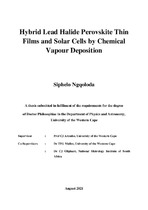| dc.contributor.advisor | Arendse, C.J | |
| dc.contributor.author | Ngqoloda, Siphelo | |
| dc.date.accessioned | 2021-08-17T12:46:03Z | |
| dc.date.available | 2021-08-17T12:46:03Z | |
| dc.date.issued | 2021 | |
| dc.identifier.uri | http://hdl.handle.net/11394/8344 | |
| dc.description | Philosophiae Doctor - PhD | en_US |
| dc.description.abstract | The organic-inorganic hybrid perovskites such as methyl ammonium lead iodide (MAPbI3) or mixed halide MAPbI3-xClx (x is usually very small) have emerged as an interesting class of semiconductor materials for their application in photovoltaic (PV) and other semiconducting devices. A fast rise in PCE of this material observed in just under a decade from 3.8% in 2009 to over 25.2% recently is highly unique compared to other established PV technologies such as c-Si, GaAs, and CdTe. The high efficiency of perovskites solar cells has been attributed to its excellent optical and electronic properties. Perovskites thin film solar cells are usually deposited via spin coating, vacuum thermal evaporation, and chemical vapour deposition (CVD). | en_US |
| dc.language.iso | en | en_US |
| dc.publisher | University of the Western Cape | en_US |
| dc.subject | Lead Iodide | en_US |
| dc.subject | Lead chloride | en_US |
| dc.subject | Thin films | en_US |
| dc.subject | Large grains | en_US |
| dc.subject | Planar perovskites solar cells | en_US |
| dc.title | Hybrid lead halide perovskite thin films and solar cells by chemical vapour deposition | en_US |
| dc.rights.holder | University of the Western Cape | en_US |

